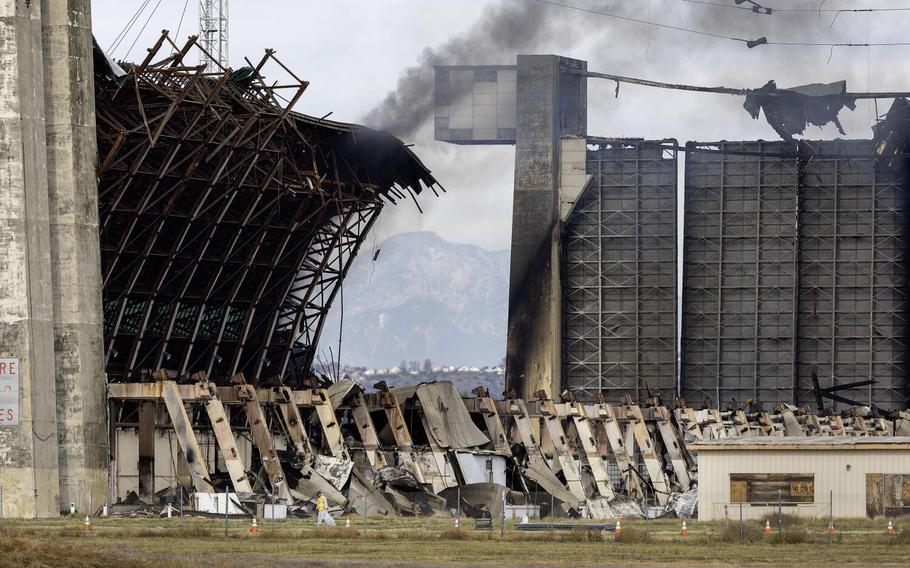
A disaster cleanup crew picks up potentially toxic debris around a World War II-era blimp hangar at the former Marine Corps Air Station Tustin, Calif., on Nov. 13, 2023. ( Allen J. Schaben, Los Angeles Times/TNS)
The Navy has committed $11 million to the cleanup of the fire that destroyed a long-shuttered World War II blimp hangar and spread toxic materials across a densely populated area around the former Tustin air station in Southern California.
But local officials said much more is needed from the service as the cost of the cleanup has topped $54 million, according to updates on the fire aftermath provided on the City of Tustin’s website.
“We need help,” Tustin Mayor Austin Lumbard said Jan. 17 at a special Tustin City Council meeting.
The U.S. Environmental Protection Agency has designated the Navy as the “responsible party” for toxic discharge from the November fire.
The Navy conveyed all but 308 acres of the 1,600-acre Marine Corps Air Station Tustin to local authorities after the base closed in 1999. However, the Navy kept control of two historic blimp hangars listed on the National Register of Historic Places.
William Franklin, spokesman for the Naval Facilities Engineering Systems Command, said funds from the Department of Defense Base Relocation and Closure program will continue to be allocated to the cleanup, but additional money has not been announced.
“The Navy is currently working with the City of Tustin on a third amendment to the cooperative agreement for an amount yet to be determined by the city,” Franklin said.
The Navy has also directly spent funds, awarding a $6 million contract to ECC Environmental to finish the deconstruction of the site’s North Hangar and remove all debris from the “footprint” covered by the hangar.
“Plans to remove the debris are being developed and will be reviewed and approved by state and federal regulatory agencies before the start of work to ensure the safety of both the community and the environment,” Franklin said.
The city and Orange County have extended states of emergency — a key to getting federal and state aid. In addition to seeking funds from the Navy, local officials are asking for additional emergency financial help from the Federal Emergency Management Agency and agencies controlled by California Gov. Gavin Newsom.
The Orange County Health Care Agency has issued updates on the county website in the past two months indicating “minimal” amounts of asbestos fibers were released by the fire. The agency also reported measurements of air quality showed the presence of metals in the atmosphere had returned to normal levels within a month after the fire.
But Dr. Regina Chinsio-Kwong, the county health officer, told county officials that the full effect of the fire won’t be fully known for up to 30 years as impacts from toxic emissions could show up in future health care and other environmental statistics.
The City of Tustin announced Friday that it had hired an environmental contractor to study soil and interior dust samples at 50 randomly selected residences by Feb. 29. Lab analysis of the samples will be compared to 30 samples taken from homes in neighboring communities outside of the impact area from the fire to look for differences in contaminants that could be related to the hangar debris.
The Navy built two massive hangars in the farmland of Orange County, south of Los Angeles, within a year after the Dec. 7, 1941, Japanese attack on Pearl Harbor brought the United States into World War II.
Two million board feet of Douglas fir lumber was shipped south from Oregon to erect the hangars to house K-12 blimps that patrolled the coast looking for Japanese ships and submarines.
Each hangar was 17 stories tall, with a length of about 1,088 feet and a width of nearly 300 feet. They were among the largest wood buildings in the world, according to the National Trust for Historic Preservation.
The Navy airship base became a Marine Corps air station in the 1950s, with the hangars used for helicopters with the 3rd Marine Aircraft Wing.
The once remote base was increasingly hemmed in by the rapid growth of Orange County, which grew in population from 131,000 in 1940 to about 2.5 million in 1990.
Local officials supported closing the base as the Pentagon sought to reduce the number of installations during post-Cold War rounds of the Base Closure and Realignment Commission.
The Tustin helicopter base and the nearby fixed-wing base at Marine Corps Air Station El Toro were decommissioned in 1999, with most units moving to Marine Corps Air Station Miramar in nearby San Diego County.
The North Hangar was shuttered following damage by a storm in 2013. The South Hangar is used for special events and local projects.